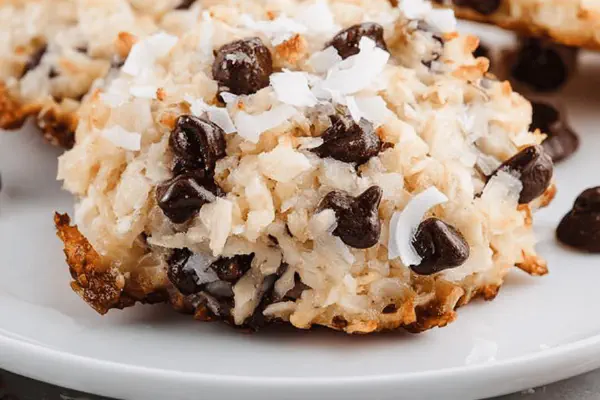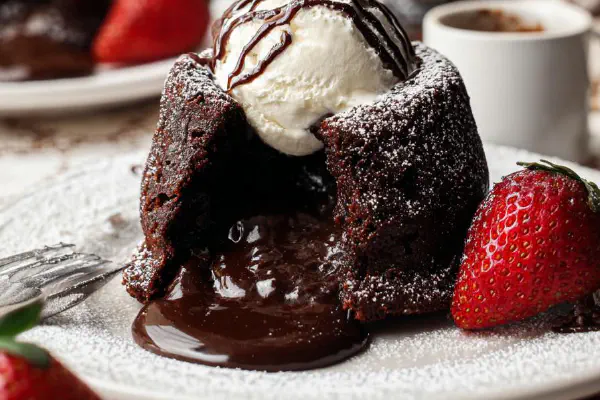Almond Joy Cookies

By Emma
Certified Culinary Professional
Ingredients
- 1 cup sweetened condensed milk
- 1 teaspoon almond extract
- 3 cups unsweetened coconut flakes
- 1 cup semisweet chocolate chips
- 3/4 cup chopped raw almonds
About the ingredients
Method
- Preheat oven to 320 degrees F. Important—low and slow to avoid burnt coconut edges and raw centers.
- Prepare baking sheet with parchment or silicone mat for even heat distribution—avoid sticking and burnt bottoms.
- In a small bowl mix condensed milk and almond extract thoroughly. Almond extract punch replaces vanilla; sharper, nuttier aroma.
- Large bowl with coconut, chocolate chips, chopped almonds. Use a wooden spoon and gently combine dry; don’t crush chips or nuts prematurely.
- Pour condensed milk mixture over coconut; fold carefully until all flakes coated—sticky but uniform. Too vigorous and chips break down.
- Wet hands slightly; scoop roughly 1 to 1-1/2 tablespoons of mixture. Shape into balls. Wet hands keep mixture from sticking and help smooth balls quickly.
- Place balls 2 inches apart on sheet. Slightly press down—flatter shapes bake evenly and hold shape better. No press? Result: towering, uneven cookies, uneven bake.
- Bake 13 to 16 minutes. Watch edges—if browning and coconut toasty smell intensifies, time to pull. Centers must jiggle lightly—gooey but stable.
- Rest on the baking sheet for 10 to 12 minutes. Crucial step: immediate removal causes breakage; cookies are soft and fragile hot.
- Transfer carefully to cooling rack after resting. Fully cooled, cookies firm but chewy, toasty coconut gives contrast to smooth melted chocolate chunks and crunchy almonds.
Cooking tips
Chef's notes
- 💡 Low oven temp matters—320 degrees avoids burnt coconut edges while letting centers set gooey not raw. Oven quirks vary; watch edges brown rich gold and smell that toasted coconut aroma. No rushing. Timing fudge 13-16 minutes based on scoop size, watch for visual and smell cues over clock.
- 💡 Wet hands when shaping—old baking trick to stop mix clinging to fingers. Scoop around 1 to 1-1/2 tablespoons, shape loosely into domes. Press slightly flat—too flat spreads cookies too much, no press means odd domes baking unevenly sometimes toppling. Use textured parchment or silicone mat to avoid sticky mess.
- 💡 Mix condensed milk and almond extract first—uniform flavor, no missed pockets of strong extract. Fold dry ingredients gently to keep chocolate chips and almonds chunky; crushing chips early turns gooey mix murky, nuts lose crunch. Moisture balance crucial—too wet means spreading flat, too dry crumbly balls.
- 💡 Rest cookies 10 to 12 minutes on baking sheet after oven off—often overlooked but key. Hot cookies are fragile, move too soon and they shatter or fall apart on rack transfer. Cooling firm but still chewy, centers soft and bouncy, edges crisp but tender. Let sit until they can hold shape without cracking.
- 💡 Substitutions possible if needed—almond extract swap adds nutty punch versus vanilla which is milder, will change aroma and flavor profile. Sweetened condensed milk is glue here; evaporated milk plus extra sugar and longer cook time can sub but changes texture. Prefer semisweet chocolate chips; darker or milk versions shift taste but chip function stays intact.
Common questions
Why do my cookies spread too much?
Likely too wet batter or oven temp too low. Moisture makes dough loose; also watch size of scoops. Pressed flat too hard or slick baking sheet can add spreading. Try chilling briefly if mix feels too loose though original method skips chill.
Can I replace almonds with another nut?
Yes but crunch changes. Walnuts or pecans work but chop coarse, roast lightly in oven with sheet before mixing. Oils can differ—peanut butter chips thrown in once messed bake texture. Avoid oily nuts raw or oily chips causing greasy spots.
How to know when cookies are done without exact time?
Look for golden edges, smell toasted coconut rising, centers should jiggle lightly when gently shaken but not liquidy. Browning edges and richer aroma signal pull time. Overbake stiffens without chew. Underbake leaves raw goo—balance sensory cues carefully.
Best way to store leftovers?
Airtight container at room temp once fully cooled. Don’t stack too tightly or cookies stick. Can refrigerate to extend life but chill firms texture, soften bite. Freeze individually wrapped for longer; thaw on sheet before serving to regain chew. Avoid plastic bags alone—trap moisture causes soggy spots.



